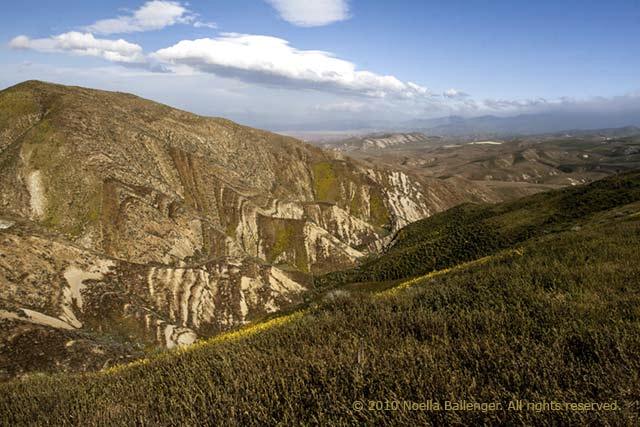
As we were nearing sunset, we stopped to view the actual San Andreas Fault line. It is wildly impressive as you imagine the amount of movement and energy released as it bent and buckled the earth’s surface in such a dramatic manner.
Photographers—we do enjoy sharing our vision of the world and I’m no exception. But it’s not just about the vision. We also hope to invoke an emotion in our viewers, and on occasion, if we’re lucky, we can have special photos trigger wonderful memories from a time in their past.
As a photo instructor, I enjoy staying in touch with my former students. I’ll share photographs with them when I have seen or done something special and I encourage them to occasionally reciprocate by sending me an image or two. I look forward to hearing from them and seeing their photographic progression.
So I would like to share what turned out to be not just a special moment for me, but a moment that caught the attention of one of my former students.
I had traveled to an area in California called the Carrizo Plain. This is a large and very special valley that is about 35 miles west of Bakersfield and is used as grazing land for free roaming range cattle. It is sandwiched between the ridges of mountains that we loosely call our Coastal Mountain Ranges … specifically, the Temblor Range and the Caliente Range. On the southwest side lies a salt crusted bed—Soda Lake. One of the magnificent geologic features seen in this valley is the famed San Andreas Earthquake Fault. This fault is the boundary between the Pacific and North American Tectonic plates and is about 700 miles long, stretching almost the entire length of California.
Characteristically and during most months of the year, the valley is very hot and dry. Then the Spring rains come and transform the area into a gigantic mud hole, making it difficult or impossible to traverse. But once the mud dries, it’s as if a fairy came flying in, waved her magic paint wand and Voila! It becomes a wonderland covered in beautiful blankets of vibrant colored flowers.
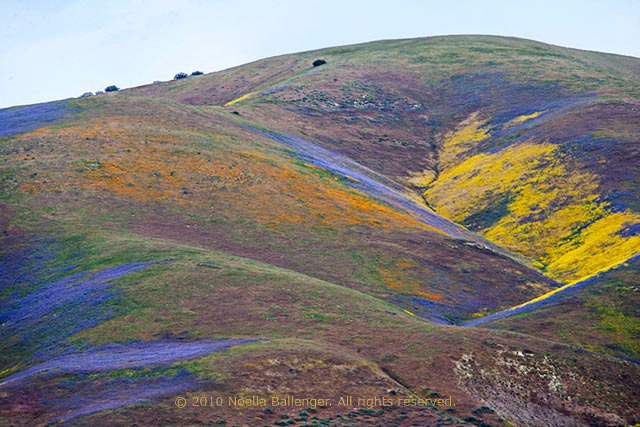
The hills were beginning to come alive with the hues and tones of flower fields.
So, out I went with the anticipation of capturing photos of the year’s incredible colors—the wildflowers that bloom sometimes only for a matter of a few days or several weeks. And I was not disappointed. I loved what I saw and had a wonderful time. When I returned home I quickly processed a couple of panoramas and shared them with some family, friends and former students. And there were many positive responses, but there was one reply that touched me deeply. Those photos did what we as photographers so hope for—they engaged the viewer not only on a visual level, but on an emotional level, bringing forth memories that had been stored away in the mind.
Leo Gallo is a photographer and past student. As a photographer he does some really lovely work … as a writer, he “blew my socks off!” Let me share with you his comments.
I looked for a long while at your images. I stretched them across my 2 big monitors, stuck my face into them and imagined I was there. I like each of them for different reasons, but I think the most poetic one is the scene with the fence. What is it about fences that stretch for miles along huge plains? I guess I like how it puts us in perspective–presumptuous often and trite. Maybe this is grazing land and the fence is necessary. Maybe it’s an egoist that just wants to say “Lovely, huh? It’s mine!” Another thought about the fence is that it’s there running counter to the fault. Thanks so much for telling me that. It brings a sense of awe to those hills. A rent in the fabric of the earth, just as that fence is a rent in its majesty. The image and the thoughts bring tears to my eyes. Not sad tears, but tear of awe!
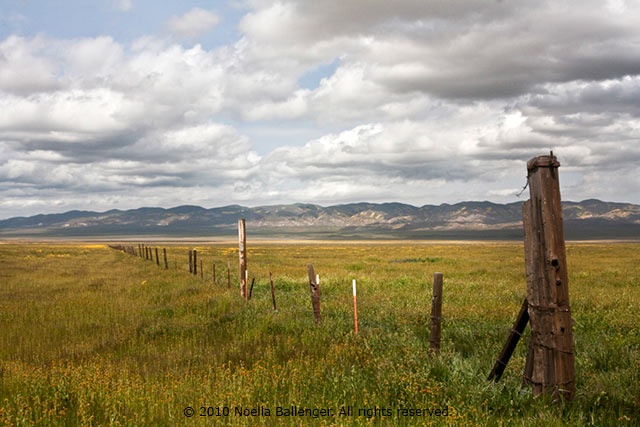
Wire fences crisscross parts of the plains to keep cattle from roaming completely throughout the area.
These images are quite interesting too. I like the textures and shocks of yellow within the Panoramas, but I especially like the one with the mountains and fault line. They look etched into the image. Were you going for that effect? The patches of flowers on the hills and the up-close-and-personal patch in the foreground and near background knit it all together. I don’t begrudge the human presence in the image. I like the structures on the right. I imagine them to be houses, but I don’t see any roads to them. I imagine them as witnesses, abiding as long as they survive. The car kicking up dust could have been me and Laurie 35 years ago, desperate to bring it back home.

Looking toward the Caliente Mountains, the low hills are a riot of color.

There are few paved roads in the Plains area and the dirt roads are always dusty. The up thrust of the San Andreas fault can be seen in the background. This geologic formation was formed when the North American Teutonic Plate and the Pacific Teutonic plate moved past each other.
And as I read Lou’s words I knew my images had made a deep connection with him and after he wrote about it, those words resonated with me. It’s a joy for me to capture a small moment in time by creating new memories. And, of course, I thought about some wonderful old ones of my own too. Thank you, Lou.
Not only is it important to capture the memories through your photographs, but if you can attach words to those images, your thoughts and feelings, then you’ve taken it a step further. I believe that as photographers we must learn to clarify what it is that we are trying to say with our cameras and photographic skills. We need to learn how to share not only with ourselves (internal thoughts), but with others by using both verbal and written forms of communication. Ask yourself if the image portrayed what you thought and felt at the time.
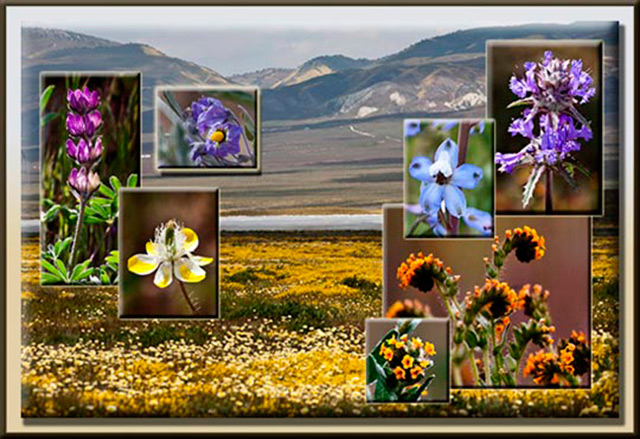
Background photo:
Looking across the Carrizo Plains at the Temblor Mountains.
Left flower group:
Left: Chick Lupine
Right: White Horsenettle
Lower: Cream Cup
Right flower group:
Upper Right: Thistle Sage
Upper Left: Gypsum Loving Larkspur
Center: Fiddleneck
Lower left: Fiddleneck
Let’s take a moment to think about how words can enhance the photographic experience. I encourage people to talk about their work—write it down. Without some practice, this can be very difficult sometimes, but as humans we have many wonderful abilities and senses. Visual, written and verbal skills are complimentary to one another. When you engage in more than one (in this case, visual, written and/or vocal expression) it seems to magnify your abilities in all areas.
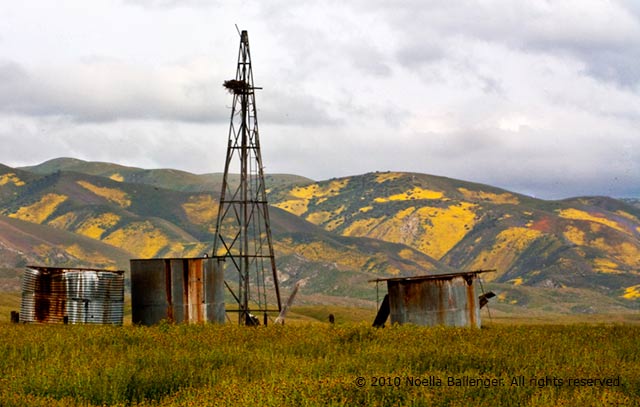
An old water pump and water tanks are abandoned in one of the fields.
Temblor Mountains in the background are filled with blooms.
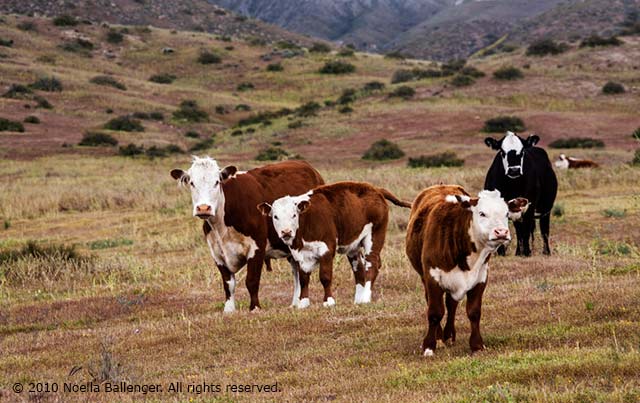
These cattle ranging on the plains are curious about our presence.
Let’s examine how this multitask approach may help you. It is often said that when a person looses their sight, the other senses become more acute. I believe this is true. It is a skill that can be cultivated and used to your advantage as a photographer.
I’ve mentioned this in a previous article, but I feel strongly about how this approach can improve your photographic skills, so I’m going to reiterate this exercise again. I frequently will take a moment to sit quietly for a few minutes before beginning to photograph. I shut my eyes and try to engage my other senses–the sense of smell, touch, hearing, and so on. And as I am doing that I try to describe what I am feeling, hearing or smelling. Conversations in my head may go something like this: “I can hear the birds and there are lots of them chattering. They are coming from my right. The sun is striking the left side of my face. It’s not too warm, but feels really good as I sit here. I’m wearing my oldest pair of boots and the liner needs to be replaced on the left foot because it is not as comfortable as the right foot. Oh, the wind shifted and it is now coming from the side and not hitting my back like it was.” And so on it goes and all of this is done in only a couple of minutes while my eyes are closed (you can take whatever amount of time you like). When I open my eyes, it is almost as though my vision has really changed and improved. I see things in a way that I did not see them before. And then I pick up my camera and go to work. The words are important in order to bring my photographic vision into the image.
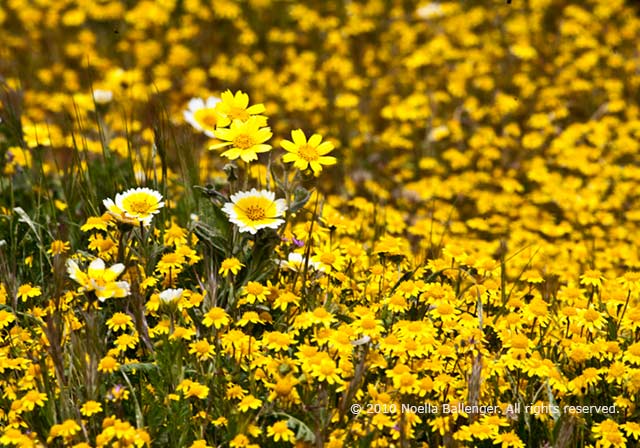
Tidy Tips and the sub-specie Yellow Tidy Tips nestle in a field of Goldfields.
Their is always the importance of seeing and photographing the “essence” of the subject and the need to make the connection between you and your viewer to give your image a feeling of intimacy–of it being “one” with the viewer. Photography is not just about the latest gear or the longest lens. It’s not just about photographic technique or workflow in your computer, but it is about sharing a bit of yourself with your images and your words.
And it is absolutely joyful when others share with you as well.
So grab your camera, pick your subject and head out the door. Start creating your own photographic memories.
by Noella Ballenger
Article and photos: © 2010 Noella Ballenger. All rights reserved.

Leave a Reply